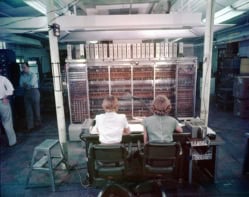
Stephen Hawking, iconoclast
When Kitty Ferguson wrote her first book about Stephen Hawking in 1991, she probably did not expect to write a sequel 20 years later. The world’s most recognizable cosmologist, however, has a knack for confounding expectations – not least those of his doctors, who diagnosed him with motor neurone disease nearly 50 years ago – and his contrarian spirit comes across vividly in Stephen Hawking: His Life and Work. Published to honour Hawking’s 70th birthday this month, Ferguson’s latest chronicle of his oeuvre is somewhat more personal than its predecessors, mixing explanations of wormholes, M-theory and the anthropic principle with brief accounts of his three children, two failed marriages and hectic life as an international scientific celebrity. She has also unearthed a few genuine stunners, including an anecdote about how Hawking “found ways to use shortcuts in taking data and faked parts of the experiments” as an undergraduate at Oxford. On the whole, though, this is very much an “authorized” biography. Ferguson’s tone is largely deferential, and though skirting around Hawking’s second divorce seems forgivable – why interrogate someone about their domestic troubles when you could be asking their views on the universe? – the uncritical marvelling that creeps into the book’s later chapters is a bit hard to take. On a brighter note, her description of Hawking’s evolution as a scientific thinker is really valuable. After his pioneering work on black-hole cosmology in the 1960s and 1970s, Ferguson writes, Hawking underwent a change of heart around 1980, when he told his longtime friend and collaborator Kip Thorne that he “would rather be right than rigorous”. That attitude goes some way towards explaining why Hawking has made grand claims for various unproven (and possibly unprovable) “theories of everything” over the years, and perhaps also why another friend, the physicist Leonard Susskind, once called him “the most stubborn and infuriating person in the universe”. This is not, however, to dismiss Hawking’s achievements. Few would dispute that he is one of the most influential physicists of his generation, and undoubtedly also one of the best at communicating big ideas to the general public. Wisely, Ferguson leaves (almost) the last word in her book to Hawking’s mother Isobel, who observes that “Not all the things Stephen says probably are to be taken as gospel truth. He’s a searcher, he is looking for things. And if sometimes he may talk nonsense, well, don’t we all?”
- 2011 Bantam Press £20.00/$27.00hb 416pp
Radioactivity redux
The story of radioactivity began with Röntgen’s discovery of X-rays in 1895. Within a few years the Curies had isolated polonium and radium. By 1909 Rutherford was firing alpha particles at gold foil. His student Bohr came up with a working model of the hydrogen atom in 1913 and before too long, the Manhattan Project was building an atomic bomb. This simplified account of radioactivity’s early years will be familiar to many, but as the science historian Marjorie Malley demonstrates in the opening chapters of Radioactivity: a History of a Mysterious Science, it is only part of the story. Indeed, the overwhelming impression one gets from reading Malley’s tale is one of confusion, with everyone from future Nobel laureates to charlatans struggling to understand the strange “emanations” of these unsettled materials. Radioactivity itself has a somewhat confusing structure, with material about industrial applications, health and other topics hived off into separate chapters rather than integrated into the history. There are, however, plenty of interesting facts in these subsidiary chapters, including a lengthy (and, as Malley points out, far from exhaustive) catalogue of how early researchers were harmed or killed by radioactivity. One of the most shocking anecdotes concerns a pioneer of radium manufacturing, the chemist Friedrich Giesel, who ended up with so much radon in his lungs that his breath could discharge electroscopes; unsurprisingly, he died of lung cancer. This worthwhile if imperfect book does justice to him and many other less-well-known figures of early 20th-century science.
- 2011 Oxford University Press £14.99/$21.95hb 280pp



